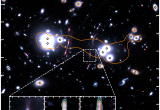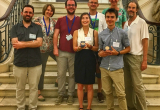Star-forming regions interact with their environment in massive galaxies
An international team of astronomers just witnessed how the sites of the most intense star formation in the early Universe communicate with their surroundings through rapid gas exchange. Their findings offer unprecedented insights into the most rapid evolutionary phase of massive galaxies, about 11 billion years ago.
Latest News
6 years 7 months ago
6 years 8 months ago
The launch of the BepiColombo spacecraft (ESA/JAXA) took place on October 19, 2018 at 10:45 pm from the Ariane 5 site in Kourou. BepiColombo has successfully started its long journey to the planet Mercury, with onboard SIMBIO-SYS, a complex of 3 instruments that will map the surface of the planet with unprecedented spatial resolution and spatial coverage. IAS is co-PI of this instrument through the supply of the main electronics and the implementation of the calibration of the integrated instrument.
6 years 9 months ago
IAS is participating to the national open lab day "Fête de la Science" in the week of October 8th. After visits by high school students, the laboratory will be open for the general public on Sunday October 14th, from 2 to 6 PM, at 209 F building.
6 years 11 months ago
Jean-Pierre Bibring, professor emeritus at Institut d'Astrophysique Spatiale (CNRS/Université Paris Sud), has received on July 15th, 2018 the COSPAR Space Science Award for his contributions to the exploration of the Solar System. This award is the most prestigious of COSPAR (Committee on Space Research), and is granted at each biennial general meeting. Among Jean-Pierre Bibring's numerous involvements, COSPAR has highlighted his responsibilities in Mars Express and Philae/Rosetta.
6 years 11 months ago
On July 4, 2018, at its annual conference held in Bordeaux, the French Society of Astronomy and Astrophysics (SF2A) awarded the Young Lecturer-Researcher 2018 Award to Miho Janvier, assistant astronomer at IAS. Her research focuses on solar flares, from their birth to their propagation in interplanetary space.












